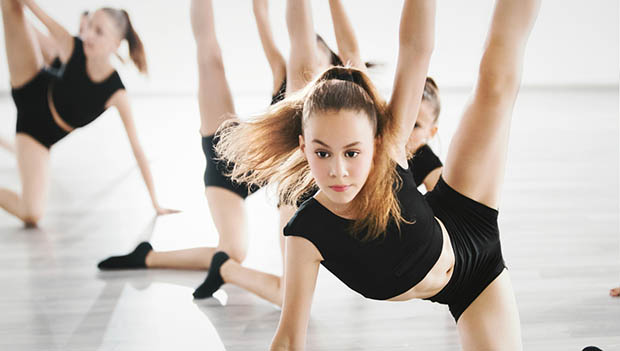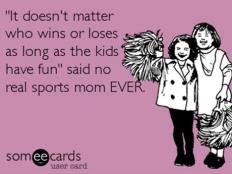
Baseball, basketball, track, swimming—you name it—there are countless ways to foster an active lifestyle for your child, be it a team or individual sport that keeps them moving and in shape.
With a focus on movement and expression, dance cultivates and strengthens skills required in any athletic endeavor as it helps not only to burn energy and stay fit, but further develop both fine and gross motor skills. There is nothing more well-rounded athletics-wise than a dance class where cardio, strength building and stretching are all a part of the daily practice.
As much as dance is an athletic endeavor it is also an art form that helps to promote strong self-awareness, social skills and confidence through creative expression. Many of the skills developed at dance class will transfer to classroom learning and academic success.
Of course you want your child to be involved in something they’re interested in, and if dance isn’t the first thing that comes to mind, put on a few dance videos or movies that feature appropriate and skilled dancing to see if they show any interest!
Dance is a healthy life-long activity that your child can benefit from well into their teen and later adult years. Here are five reasons why you should consider signing them up today!
Physical Fitness & Coordination
Signing your child up for a dance class is signing them up for an opportunity to exercise their whole body–arms, legs, lungs, heart and mind. Routines and movements practiced in early childhood dance classes will help increase your child’s flexibility, strength, endurance and coordination.
Whether through the pliés and relevés or leaps and spins across the floor, your child will have opportunities in dance to improve coordination at their own pace and without the feeling that they’re working on something “hard.” To dance is to put together a series of controlled movements, and learning to control movement requires awareness of your body’s limits in physical space through trial, error, practice and play.
Signing your child up for dance will give them a structured opportunity to grow in these areas, which will help them with whatever stage of development they’re in. Gross motor tasks include running, jumping, skipping and balancing while fine motor tasks include turning pages, using small tools (like a pencil to write) and buttoning an outfit.
No matter your child’s stage of development, learning to control muscle movements to hold and execute dance positions will help them meet early-life milestones through playful, well-balanced exercise.
Social Awareness and Collaboration
Dance is neither a team nor individual sport—in some ways, it’s both.
A dance class provides your child an opportunity to express themselves around their peers, building confidence and communication skills. A positive dance environment can do a lot to break down barriers and help manage any social anxiety. It’s an opportunity to express their own uniqueness and embrace others’ as well.
In a dance class, your child will be able to meet and work with many different peers, all while working at their own pace. They will have to take turns, follow a leader and even be the leader in various class exercises and performances. They will also learn to stay in their space during exercises and routines to make sure they don’t run into others (and that others don’t run into them), which is also a part of developing their coordination and spatial awareness.
To succeed, the class has to work together as a whole to support each other just as any team would be required to do.
Discipline and Perseverance
To move is natural and innate; to learn any form of dance simply requires practiced control or application of that movement.
Early dance classes will capitalize on the natural inclinations children have to move, bounce, flail, run and hop while also teaching them small controlled movements and isolations like pointing their toes or raising one arm. Through this, children develop a strong awareness for what their bodies can and can’t do, which ultimately helps them see what they’re working toward.
Whether it’s splits, a pirouette or a grande plié, your child will begin to see the progress toward greater diversity in and control over their mastered movements.
They will have the opportunity to learn through the trials and errors of not “getting it right” the first, second or third time, but doing so eventually. To transfer that into a classroom learning environment reduces a lot of the stress and expectation when learning something challenging and new in other areas like math and reading.
Dance also often comes with performance opportunities, and it will require endurance to see these shows through to their final product.
To really benefit from dance is often to stick with it over a period of time long enough to see progress. The great thing about all of it is that the lesson and value of sticking to a practice schedule or commitment to reach a goal transfers far beyond the dance room or stage and deep into the way your child will manage other athletic or academic challenges.
Cognitive Development
There are strong ties between core subject matter learning (math and literacy) and dance. Whether you get into the studies and claims set out by leading educational theorists or not, there is a lot of evidence right under our noses that dance and creative movement help prepare young learners to read, write and gain number sense.
For example, the alphabet is not only sung but also taught through various types of movement where each letter has an assigned physical response related either to a word that starts with that letter or the sound it makes when said out loud. There are endless songs and movement activities used to help with counting.
Dance engages both sides of the brain at the same time. This increases synapses for processing technical and creative concepts and procedures. Giving meaning to physical movement and steps in a dance class will help a child in their early education prepare for giving meaning to the numbers and letters in math and science.
Emotional Wellbeing & Creativity
Dance is expressive. Since we are able to move before we are able to speak, it is also a method of expression that goes back to an innate part of who we are as human beings. Enrolling your child in a dance class will give them a platform and a place in which to learn about themselves and their own interests, abilities and uniqueness.
Dance can help establish an appreciation for other cultures and communities as it is practiced in many forms and pairs with music that comes out of different parts of the world.
Early dance education also provides a lot of creative movement in which a child is able to choose their own ways of expressing their own thought, emotion or story. This will draw on their creativity and uniqueness, helping them embrace who they are, what they enjoy and how they want to share the stories in their heart and mind.
READ THIS NEXT: Life Lessons From Gymnastics









Discuss This Article